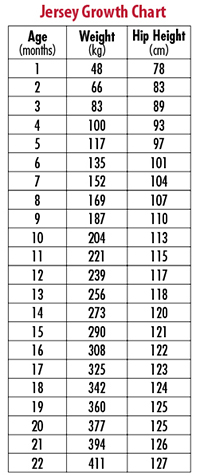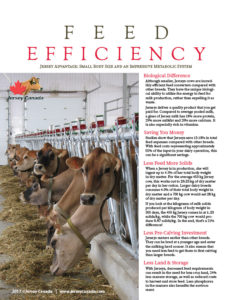FEEDING JERSEYS
BIOLOGICAL DIFFERENCE
Although smaller, Jerseys cows are incredibly efficient feed converters compared with other breeds. They have the unique biological ability to utilize the energy in feed for milk production, rather than expelling it as waste.
Jerseys deliver a quality product that you get paid for. Compared to average pooled milk, a glass of Jersey milk has 18% more protein, 29% more milkfat and 20% more calcium. It is also especially rich in vitamins.
SAVING YOU MONEY
Studies show that Jerseys save 13-18% in total feed expenses compared with other breeds. With feed costs representing approximately 55% of the input in your dairy operation, this can be a significant savings.
With Jerseys, decreased feed requirements can result in the need for less crop land, 24% less manure storage, as well as reduced costs to harvest and store feed. Less phosphorus in the manure also benefits the environment.
View or download our 8-page brochure that talks about the efficient and profitable Jersey cow, breed progress, and why the Jersey breed is perfect for today's dairy operation.
LESS FEED MORE SOLIDS
When a Jersey is in production, she will ingest up to 4.5% of her total body weight in dry matter. For the average 450 kg Jersey cow, this works out to 20.25 kg of dry matter per day in her ration. Larger dairy breeds consume 4.0% of their total body weight in dry matter and a 700 kg cow would eat 28 kg of dry matter per day.
If you look at the kilograms of milk solids produced per kilogram of body weight in 305 days, the 450 kg Jersey comes in at 1.23 solids/kg, while the 700 kg cow would produce 0.97 solids/kg. In the end, that’s a 21% difference!
Jersey cows are fed in a similar way to all other breeds of dairy cattle. However, there are some things to bear in mind when balancing a ration for Jersey cows. Here are some factors to consider:
- Jerseys have been documented to eat a greater percentage of dry matter (DM) in relation to their body weight (4.5%) than larger breeds(4.0%)
- Energy Levels - This is not as critical of a concern in a Jersey ration, given lower maintenance requirements, but should still be balanced accordingly.
- Crude Fat Levels in a Jersey ration should often be at a lower level than Holstein ration, preferably 4.5% or less
- Copper Levels - Keep copper at 20ppm in a Jersey ration, less than for Holsteins.
- Do not overfeed any one feed source - a balance of sources is preferred, as in any breed.
- Sharing one ration between two or more breeds is very possible. Work with your nutritionist to find the balance. It may often mean optimizing the ration for the Jerseys, and allowing for the larger breed to simply eat more, taking advantage of their size.
Range of Recommended Jersey Heifer Weights and Heights

Jersey Calf and Heifer Growth Chart

(Source: 2008 Penn State College of Agricultural Sciences)
FEEDING JERSEY
Jerseys mature earlier than other breeds. They can be bred at a younger age and enter the milking herd sooner. It also means that you need less feed to get them to first calving than larger breeds.
What is the difference between feeding Jersey heifers and heifers of larger breeds?
Typically, Jerseys mature faster than other breeds and can be at risk of becoming overweight if overfed. This is may be an issue when they are mixed with other breeds as larger breeds need more energy in order to meet their genetic potential. Often, the high energy ration fed to both breeds can result in the Jerseys becoming overweight, where growth may slow down and fat can deposit in the udder - therefore reducing future milk production. To avoid this problem, lots of hay should be fed and Jerseys might be moved with an older group as soon as they appear too heavy. Competing with heifers three months and older will help to reduce weight and should more closely match the feed the heifer requires at that age.
Ensure that your heifers have lots of space for exercise, which will also contribute to the proper body condition. A common mistake is to group heifers by size, rather than age, when Jerseys and larger breeds are in the same pen. This increases the problem for Jerseys to get too much energy. In the situation where size is comparable, the younger heifers of larger breeds could still be on calf starter while the Jersey is on a heifer ration with lots of hay.
The problems described above could result in accelerated weight gain where too high of energy intake becomes a problem and needs to be monitored. Assessing the body condition of the heifers in each pen and making some changes will help.
MORE THAN JUST A PRETTY FACE
As gatekeepers of Jersey data and providers of multiple tools and programs, Jersey Canada helps breeders make good decisions. Our services can support your profit model, assess the breeding value of your Jerseys, improve your stock, build on your investment, and develop the breed as a whole.
Most people can appreciate the pure beauty of a Jersey cow. Her good looks, high components, easy calving and incredible character. Our Feed Efficiency FACT SHEET will also help you understand how the Jerseys small body size and impressive metabolic system make her an excellent choice when adding cows to the herd. She can save you money in so many ways. Read the facts.


